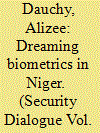|
|
|
Sort Order |
|
|
|
Items / Page
|
|
|
|
|
|
|
| Srl | Item |
| 1 |
ID:
190677


|
|
|
|
|
| Summary/Abstract |
Since 2015, Niger has been actively committed to migration control in West Africa in the context of the European Union Emergency Trust Fund for Africa. To enable better comprehension of the making of security in Niger, this article studies the implementation of biometrics under the EU Trust Fund by international agencies (Interpol, the International Organization for Migration, UNHCR) and national actors. Drawing on in-depth interviews, observation and anthropology of aid studies, I argue that biometrics is a travelling organizational model translated into a multiscalar process by state and non-state actors embedded in relations of power. Biometric technologies cannot be reduced to an added-value instrument for Nigerien authorities in order to enhance legibility, to better identify Nigeriens and foreigners crossing Niger’s borders within the free-movement area of ECOWAS (Economic Community of West African States). I focus on heterogeneous actors’ situated discourses and practices to demonstrate that they do not share the same dream about biometrics. In practice, however, biometrics helps international actors to produce their own security knowledge in Niger that, in the end, augments the capacity to trace ECOWAS citizens and reinforce the EU border regime.
|
|
|
|
|
|
|
|
|
|
|
|
|
|
|
|
| 2 |
ID:
181943


|
|
|
|
|
| Summary/Abstract |
Building a national system of social governance (guojia zhili tixi), which is the long-running governance dream of Xi Jinping, has triggered the creation of China’s ‘smart state’ using the tools of new information technologies to advance governance capacity (zhili nengli). These systems were already deployed nationally when the COVID-19 pandemic hit China, but were connected at a lesser capacity, targeting specific domains of security, industry or government administration. In response to the crisis, multiple technologies have been merged, exceeding the scope of their originally intended functions. This is known as function creep, when surveillant technologies remain functional past achievement of their intended purpose, or surveillant assemblages, where multiple surveillant technologies are combined. As more countries turn to digitalisation to increase public security and intensify social and market governance, the expansion of surveillant functions in China and their now-palpable effects on people’s lives raises new and pressing questions for scholars and decision-makers alike.
|
|
|
|
|
|
|
|
|
|
|
|
|
|
|
|
|
|
|
|
|